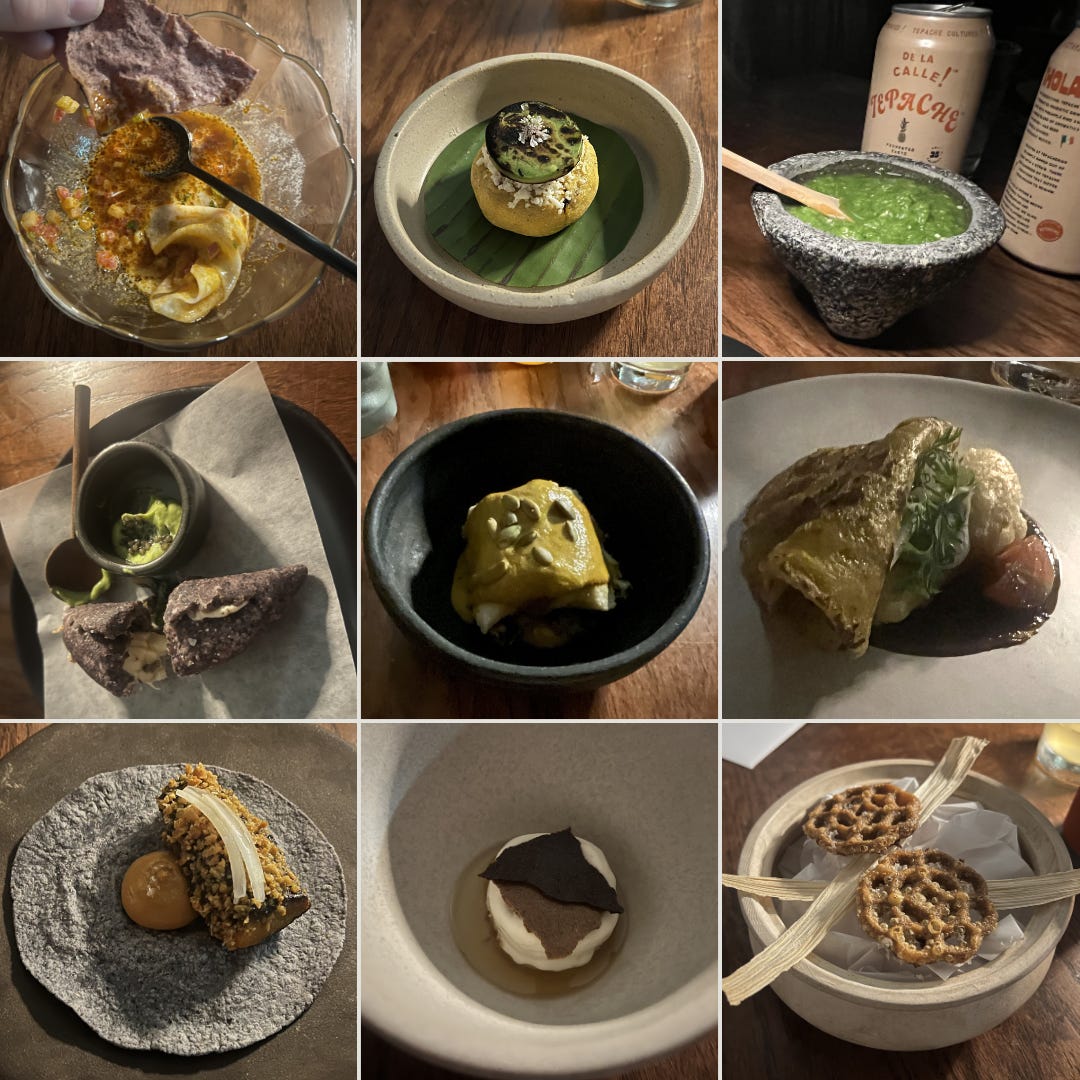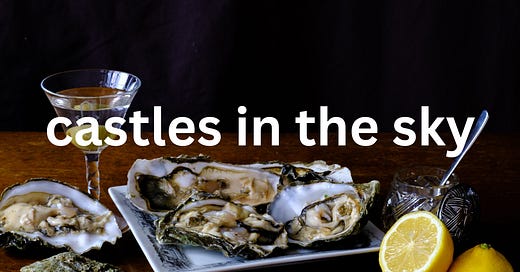

Discover more from Castles in the Sky
This is part of the Vignettes series, where each edition takes a big idea and then deconstructs and savors it through bite-sized literary morsels. The hope is to diverge from the central idea and converge back on that idea with an expanded palate. This issue is about a high-end tasting menu dinner I had that inspired this new series. It is longer and more narrative-driven than future issues of Vignettes will be.
Many people don’t know that my hometown Houston has a legitimate argument for one of the food capitals of the United States. The Greater Houston area boasts over seven million people, many of whom are immigrants. Real estate is cheap, there is little regulation, people like to mix, and everyone likes to eat. Because of the extreme diversity of inputs, you can see what restaurants are capable of here. It’s a recipe for great food in unlikely places.
Last week, my sister brought her family to town and she, my brother-in-law, my wife, and I decided to try out a tasting menu for Tatemó, a restaurant we later discovered had been ranked #2 in the city the year prior. In true Houston fashion, Tatemó was just off a state highway in a nondescript shopping center next to a Spanish-language evangelical church surrounded by industrial warehouse businesses.
There was a very well-dressed guy on the sidewalk in a full suit welcoming people but he took one look at us and said we wanted next door. We realized he was waving people into the church. Judging by the storefront and the “bare bones” of the room the restaurant was in, it could have just as easily been an insurance office or small jeweler. The windows of the restaurant were blacked out with tint and the inside was very dim with seating for maybe sixteen people. (This is unusual for Houston, which has few of these small types of restaurants and has many cavernous Tex Mex, barbecue, dim sum, and seafood restaurants.) The whole place was decorated very tastefully with art that seemed culturally significant (but frankly I don’t know enough to know if that’s the case).
The dimness of the restaurant and the huge variety of tastes and presentations made it hard to keep track of time, plus there was no menu offered before the meal. Everything was prepaid when we made the reservation and there was no deviation from the seven-course arranged meal. Each course was distinct and delicious. I had done some cursory googling on the drive over and vaguely understood that the chefs found creative ways to use, elevate, and combine different kinds of maiz (corn) indigenous to Mexico and that at least one of the chefs was from the Oaxaca region of Mexico, but beyond that, I did not know much.
Before each course, they wiped down the table and replaced the silverware, then the server came out, explained the story of the next course, and explained how to eat it. The server suggested that we try one of their specially ordered drinks called Tepaches, which he said was similar to Kombucha but fermented from fruit rinds rather than tea, or a Jarritos, a Mexican soda, to pair with the food since none of us was in the mood for alcohol. I grew up on Jarritos so I ordered the Grapefruit Lime Tepache for the early courses and a Mango Chili Tepache for the later courses, as the server recommended. Both were perfect.
The first course was a jicama ceviche made with yuzu aioli, pico mix, and corn milk. When I google Jicama, people say that it’s similar to a potato but I’ve always thought of it more like a radish. It’s often used in low-carb dishes and made into soft things like fake tortillas. We were given a tostada to eat the jicama with. I was shocked right away with how good it all was. The tostada was a light blue/gray color. I imagine if there are billionaires who love corn chips then the corn chips they eat taste like that tostada.
The server said we could “knock back” the ceviche juice when we were finished with the tostada and mimed a gesture like picking up the bowl and slurping it out, but I thought it was a figure of speech and there was no way I should be picking up the bowl of the table in a place this nice to drink the leftover ceviche juice. So I used the tiny spoon to greedily slurp up the last of it like a little ceviche fiend. When he came back, he told me that no, in fact, we could have just drank out of the bowl and that’s what they recommend.
Once they removed the first course and wiped the table down, I was worried we wouldn’t get enough food–that is, after all, the canonical joke about fine dining, that you always grab a cheeseburger on the way home. The second course was a gordita. (At this point, I want to remind you that I’m neither a food critic nor an expert in Oaxacan cuisine or Mexican maiz.) This dish tasted kind of like a small muffin with the consistency and taste of the most delicious corn tortilla I’ve ever had.
After the gordita was finished, they brought us each a quesadilla that looked and tasted similar to what I usually get when I order an empanada. It was the first dish with an animal product in it. With this course, they brought out a phenomenal fresh salsa made with jalapeno and something else that the server said would accompany every course up until the dessert. I had to stop myself from drinking it. The quesadilla was served with a small dollop of creamy avocado with caviar and Oaxacan cheese inside a fried corn tortilla.
By the end of the third course, I had completely lost track of time and which course we were on. I asked everyone else at the table and nobody knew, they were just floating through the delicious spacetime maiz vortex with me. I had to look at the pictures of our food on my phone to get my bearings. We were on the third course. I asked the server when he came back if the whole meal was meatless by design or just a coincidence and his answer was interesting and surprising.
He said that it was mostly a coincidence but that a lot of fine dining and high-end tasting menus are going that way. He name-dropped 11 Madison Park, the New York City restaurant that was one of the best and most exclusive in the world when it opted for a full vegan menu in 2022. (It has since had some problems.) He said, “it’s hard to distinguish yourself sending out a bunch of NY Strips medium rare, but a lot of restaurants are taking up the challenge of working with local, vegetables and changing seasonal menus.” As someone who loves steak but was thoroughly impressed by the meal up to that point, it was an interesting perspective I had not heard before.
The fourth course was a tamal (which is the singular of tamales–which I did not know before that). It made me wonder if all the tamales I’ve had up to this point were just doing an impression of that one. It tasted like a cornmeal cloud, very fluffy but not light, covered in some kind of creamy sauce with nuts or seeds on top, and laid on top of grilled vegetables. Among the grilled vegetables was chopped cauliflower which was the best cauliflower I’ve ever eaten in my life. After that was mole (pronounced molay if you’re unfamiliar), which was topped with a corn tortilla which supplanted the gordita as the best tortilla I’ve ever had.
For the next course, we had a taco with smoked sweet potato covered in walnuts. I’ve had grilled vegetables but I’ve never had anything besides meat that tasted this smoked before. It was covered in walnuts and had a dollop of peanut sauce and another of the most excellent tortillas I’ve ever eaten. (At this point, my mouth and my brain stopped fighting. I preserved that brainpower and so elected to stop ranking the tortillas. Instead, when people ask how the food was, I will just say, “the best tortilla I ever had was at Tatemó.”)
The second to last course was an ice cream dessert. In the ice cream, there were nixtamalized persimmons. Nixtamalization is a traditional cooking method used in Mexico where corn is soaked in limewater made from water and calcium hydroxide (or another alkaline solution) which preserves it, makes it easier to process, removes toxins, and enhances the corn. I had to google nixtamalization to find out what it was and in the process discovered it was a culturally and logistically very important process to many Mesoamerican cultures. I don’t know how much it was responsible for changing the persimmon taste as I rarely eat them, but the persimmon in the ice cream tasted almost pickled. They were a very nice surprise mixed in along with the “mole crisp” on top of the ice cream. There was also melted butter around the ice cream. (Eating melted butter with ice cream opened a door in my brain I wish had remained closed. Since then I can’t stop wondering how to put melted butter on ice cream.)
The final course, which the waiter referred to repeatedly as “a snack,” was a Bunuelo. This looked and tasted like a small pretzel made of corn chips that had been dipped in a very light milk chocolate and covered in sea salt and Macadamia nut shavings. Unlike the middle five courses where I showed class and composure after fiendishly slurping my ceviche in the first course, I ate the Bunuelo very quickly and said, “I could eat a garbage bag full of these.” I meant it, too. I was unashamed.
We were comfortably full when we left. None of the four of us disliked anything and all of us had a different favorite. Mine was the jicama ceviche, my wife’s favorite was the tamal, my sister’s the quesadilla, and my brother-in-law’s the taco. Overall, the food was fantastic and we all had a blast. I wish I knew enough about food to eat at restaurants like this and write about it for a living. But as much as I love to eat, food to me is just bad, good, amazing, or life-changing. I rate the meal at Tatemó as life-changing, not just because the food was fabulous and it reaffirmed for me that I love tasting menus, but because it gave me a great new metaphor to use when thinking about writing.
We received a paper menu at the end of the meal clarified that the variety of tastes and textures we’d experienced throughout the evening were all unified by a single ethos: “to restore the cultural value of maíz, and its nutritional value in Houston, Texas by showcasing the diversity of heirloom corn, from different landscapes and purveyors of Mexico via masa products like tortillas.” It was revelatory how expansive the experiences could be and how they could serve to reinforce my understanding of something by diverging and converging again.
At each course, we had indeed had a different kind of corn, or something tangential to corn. I could have just walked out and thought, “what a a diverse and delicious dinner.” Instead, I thought to myself, “corn! Oh my God, we’ve been doing it all wrong.” That explicit theme was able to make the breadth of ideas and experiences work in service of the depth of the specific lesson: the culture and nutritional value of maiz. As soon as I understood this, my mind started spinning with how this might apply to writing. It helped me better understand my own body of work and how I might be more creative in the future in service of reaching more people.
A tasting menu is a great metaphor to wrap my mind around what I’ve been trying to create with my body of work over the last two years. I have been writing essays, fiction, memoirs, book reviews, and whatever else felt right whenever it felt right. The variety of ideas and content may make it hard to find the thread that unites them. I want subscribers to feel the way I did in that dining room, engaged and delighted by the thought-provoking parade of experiences coming their way. But even though everything feels different, all my writing comes from the same well of inspiration. There is a unified purpose.
My writing has always been about exploring how we can be transformed by authenticity, open-mindedness, and the power of storytelling, and–once transformed–how we can transform the world around us. It’s why I’ve used introspection, inspiration, and idiosyncrasy as a tagline for so long. Cultivating authenticity is often a byproduct of introspection. Being open-minded means finding the truth and beauty in life’s idiosyncrasies. Storytelling is about inspiring others and allowing ourselves to be inspired.
However, as central to my writing as these ideas have been, I have not been interested in writing expository essays about these principles so much as showing them in action and seeing what they look like out in the world. In the same way the waiter didn’t come out and tell us about the GDP of the region or give us history lessons, I am not aiming for direct instruction. However, after my revelation from the physical menu at the end of the tasting menu, I realized I might better frame what I’m doing and synthesize it for people so they get more out of it. I loved the meal and would have enjoyed it and learned a lot regardless, but I was able to walk away with so much more by engaging directly with the server and reading the paper menu at the end.
Beyond helping me understand what I’ve been doing, the tasting menu gave me an interesting lens on the future. It seemed like a great metaphor for a “small-bites” email format. On the night after the meal at Tatemó, I considered what a tasting menu would look like for writing. It would probably be the exploration of a compelling theme or idea with an assortment of bite-sized stories, ideas, and links that all give different vantage points and offer different experiences around that theme or idea. As I’ve been working on longer projects, I’ve been wanting to find a way to share shorter snippets of things with you, so I’m going to experiment for the next four weeks and pilot this exact feature.
Starting next Sunday and continuing for the three weeks afterward, I’ll release a new feature called Vignettes. Each issue will explore a new theme or idea via bite-sized pieces of written content that give a variety of perspectives on it. I hope that, as I did during the tasting menu, you may come to know and understand something better through a varied, enjoyable, and potentially challenging experience.
Postscript: On the drive home, the four of us talked about how much we would pay to eat a meal like that going forward. As delicious as it was, the meal was light, and it was very expensive.
There was mild discussion about whether we’d pay that much to eat at a place more often. In the end, we all agreed unanimously that to think of paying the restaurant for the ingredients and your level of fullness when it comes to a place like Tatemó is short-sighted. We are not just paying for that (which we all more or less agreed warrants the high price on its own). We are also paying as a vote to say, “I am glad that a place like this exists. I want more people to do things like this, and I want you to continue doing things like this.”
To that end, there is a paid tier here on Castles in the Sky. You can use $8 per month to say, “I am glad that a place like this exists. I want more people to do things like this, and I want you to continue doing things like this.” For now, there is no separate tier or paywall, everything is released for free. But some big changes are coming, and your support now would mean a lot.

















Loved the analogy Charlie, spot on.
And, coming from a Mexican that has pretty much eaten some variation of corn everyday since I was born and what I most miss when abroad are tortillas, your dinner sounds superb!
Man, this sounds like a meal I'd travel for. I love so many of these ingredients, having grown up on Mexican food in L.A., but I've never had a Mexican tasting menu like that. Loved vicariously experiencing the spacetime maiz vortex through this wonderful piece.
I'm excited to see what your "tasting menu" looks like.